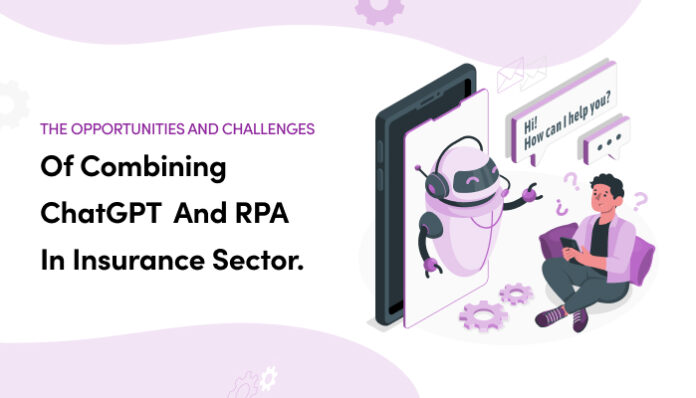The insurance sector is on the cusp of transformation. Blending robotic process automation (RPA) with advanced chatbots like ChatGPT can bring a range of efficiency and customer-centric improvements, from streamlining policy applications to speeding up claim processes.
But it’s not all rosy—insurers need to be aware of potential pitfalls, such as integration complexities and data security concerns.
Let’s look at both technologies, including the opportunities and challenges they present in the insurance sector.
Introduction to RPA and ChatGPT
RPA is the use of software robots to automate routine business processes. RPA bot development can provide immense cost and efficiency savings while improving accuracy and freeing up staff for other work.
ChatGPT is a cutting-edge chatbot technology that combines natural language processing (NLP) with GPT-3—the world’s largest language model—to create an AI-driven conversational interface. It offers a human-like dialogue, responding to customer queries and improving the overall user experience.
The Role of RPA in Insurance
RPA can automate various insurance-related tasks—from underwriting and claims processing to policy management. By automating routine processes, insurers can improve accuracy and speed up the entire process while freeing up staff for more complex work.
RPA services can reduce errors in customer data entry and ensure compliance with regulatory requirements. It can also help insurers quickly and accurately assess risk by analyzing vast swathes of customer data in a short space of time.
Key Benefits
- Streamlined Data Entry: Automates repetitive tasks, reducing human errors and improving efficiency.
- Policy Management: Simplifies the policy issuance and renewal process by automatically handling data and documentation.
- Claims Processing: Speeds up claims assessment and payout by automating verification and approval processes.
- Fraud Detection: Scans vast amounts of data to identify unusual patterns or discrepancies, aiding in early fraud detection.
- Customer Service: Provides instantaneous responses to routine inquiries, enhancing customer satisfaction and engagement.
The Potential of ChatGPT in Insurance
ChatGPT can provide insurers with a conversational interface that responds to customer queries in a human-like manner. This improves the customer experience and increases customer satisfaction levels, as customers no longer have to wait for an answer from an insurance agent or trawl through complex FAQs.
Key Benefits
- Conversational Interface: Provides sophisticated and human-like responses to customer inquiries.
- Improved Client Experience: Reduces the need for customers to wait for agent responses or navigate complex FAQs.
- Versatility:
- Underwriting and policy management
- Fraud detection
- 24/7 Support: Facilitates round-the-clock automated customer assistance.
Synergies between RPA and ChatGPT
Both technologies have distinct capabilities that, when combined, could result in a powerful tool for streamlining operations and enhancing customer service.
RPA, with its ability to automate repetitive tasks, can greatly increase the efficiency of back-office operations. It excels at data extraction, processing, and management—tasks that are crucial in insurance but can be time-consuming when done manually.
On the other hand, ChatGPT can simulate human-like text conversations. This capability can provide instant, accurate, and personalized responses to customer queries, thereby improving the quality of customer service.
By merging these two technologies, insurance companies can create a system where RPA handles routine administrative tasks while ChatGPT handles customer interactions. This synergistic combination could lead to significant operational efficiencies and more satisfied customers.
Potential Benefits and Opportunities of Combining These Technologies
Integrating RPA and ChatGPT in the insurance sector unlocks impressive efficiency gains. Insurance companies stand to benefit by automating mundane tasks, allowing their staff to zero in on complex, value-driven duties. Imagine swifter claims processing, pinpoint precision in policy underwriting, and an elevated standard of service.
But there’s more. Regarding customer experience, ChatGPT offers real-time, 24/7 support, efficiently resolving queries and supplying information. RPA’s speed and accuracy can lead to more satisfied customers.
Beyond these benefits, the marriage of RPA and ChatGPT churns through vast data streams, revealing golden insights. Insurance firms can leverage these to fine-tune their offerings, bolster risk evaluations, and steer pivotal strategies.
Challenges in Implementing RPA and ChatGPT in Insurance
Integrating RPA and ChatGPT in the insurance sector is promising, yet it’s not without obstacles. These span technical intricacies, regulatory hoops, and the nuances of training and adaptation.
Technical Roadblocks
- Integrating RPA and ChatGPT is a sophisticated dance. Each boasts distinct features and demands, making a seamless union challenging. For instance, while RPA thrives on structured data, ChatGPT dives deep into unstructured text. Crafting a dialogue between these two demands both technical prowess and meticulous design.
- Data security is paramount. With both technologies swimming in vast seas of personal and financial data, fortifying against cyber threats is non-negotiable.
Regulatory Labyrinth
- Navigating the AI and automation regulations in the insurance realm is crucial but complex. These guidelines, designed to safeguard consumers and uphold market integrity, can be stumbling blocks for RPA and ChatGPT implementations.
- Insurers tread carefully: AI’s use shouldn’t foster bias or discrimination. Additionally, the global span of insurance demands a robust grasp of data protection mandates.
The Human Factor: Training & Transitioning
- Welcoming new tech means prepping the workforce. Employees must grasp RPA and ChatGPT’s workings, adjusting to the resultant shifts in their daily tasks.
- Automation might stoke job security fears. Quelling such anxieties and orchestrating a frictionless changeover hinges on decisive leadership, transparent dialogue, and unwavering backing.
The Next Frontier of RPA and ChatGPT in Insurance
RPA and ChatGPT are powerful technologies with the potential to transform how insurers operate. With their data-driven insights and human-like conversations, they can revolutionize policy underwriting, claims processing, fraud detection, customer service—the list goes on.
However, integration is a complex process that comes with challenges. It takes deft technical prowess, comprehensive regulatory understanding, and a clear pathway to transitioning staff to tackle these obstacles.
Insurance companies embracing this new age of AI and automation could be poised for immense gains in efficiency and customer satisfaction—a tempting prospect. Will your organization be the one that takes the leap?
With the right plan, expertise, and technology, it just might be. Start exploring your options today, and you may find yourself well on your way to a new era of digital transformation in insurance.
Achieving Maximum Value from RPA & ChatGPT Integration
The potential of integrating RPA and ChatGPT in the insurance sector is tremendous—but it can only be truly realized through smart deployment.
Firms should assess their current operations to identify how robotic process automation services and ChatGPT can best serve them. This involves pinpointing areas that could benefit from increased automation and restructuring existing processes where needed. Properly mapping out objectives is critical for successful implementation.
Insurers should develop a long-term vision of how technology will fit into their operations. This approach helps ensure that the technologies enhance customer service and streamline processes—not simply as a “nice to have.”
Finally, firms should select reliable third-party vendors with expertise in RPA and ChatGPT. These partners can help bridge the knowledge gap, deliver quality services and ensure minimum disruption to operations.
There’s no better time for insurance firms looking to transform their processes with RPA and ChatGPT. With a well-thought-out plan and qualified RPA consulting partners, you can begin your journey toward an increasingly automated future today.















